
Aztec mythology is the body or collection of myths of the Aztec civilization of Central Mexico. The Aztecs were Nahuatl-speaking groups living in central Mexico and much of their mythology is similar to that of other Mesoamerican cultures. According to legend, the various groups who were to become the Aztecs arrived from the north into the Anahuac valley around Lake Texcoco. The location of this valley and lake of destination is clear – it is the heart of modern Mexico City – but little can be known with certainty about the origin of the Aztec. There are different accounts of their origin. In the myth the ancestors of the Mexica/Aztec came from a place in the north called Aztlan, the last of seven nahuatlacas to make the journey southward, hence their name "Azteca." Other accounts cite their origin in Chicomoztoc, "the place of the seven caves", or at Tamoanchan.

The Aztecs were a Mesoamerican culture that flourished in central Mexico in the post-classic period from 1300 to 1521. The Aztec people included different ethnic groups of central Mexico, particularly those groups who spoke the Nahuatl language and who dominated large parts of Mesoamerica from the 14th to the 16th centuries. Aztec culture was organized into city-states (altepetl), some of which joined to form alliances, political confederations, or empires. The Aztec Empire was a confederation of three city-states established in 1427: Tenochtitlan, city-state of the Mexica or Tenochca, Texcoco, and Tlacopan, previously part of the Tepanec empire, whose dominant power was Azcapotzalco. Although the term Aztecs is often narrowly restricted to the Mexica of Tenochtitlan, it is also broadly used to refer to Nahua polities or peoples of central Mexico in the prehispanic era, as well as the Spanish colonial era (1521–1821). The definitions of Aztec and Aztecs have long been the topic of scholarly discussion ever since German scientist Alexander von Humboldt established its common usage in the early 19th century.

Ehecatl is a pre-Columbian deity associated with the wind, who features in Aztec mythology and the mythologies of other cultures from the central Mexico region of Mesoamerica. He is most usually interpreted as the aspect of the Feathered Serpent deity as a god of wind, and is therefore also known as Ehecatl-Quetzalcoatl. Ehecatl also figures prominently as one of the creator gods and culture heroes in the mythical creation accounts documented for pre-Columbian central Mexican cultures.

In Aztec mythology, Xolotl was a god of fire and lightning. He was commonly depicted as a dog-headed man and was a soul-guide for the dead. He was also god of twins, monsters, misfortune, sickness, and deformities. Xolotl is the canine brother and twin of Quetzalcoatl, the pair being sons of the virgin Chimalma. He is the dark personification of Venus, the evening star, and was associated with heavenly fire. The axolotl is named after him.

Coatlicue, wife of Mixcōhuātl, also known as Tēteoh īnnān is the Aztec goddess who gave birth to the moon, stars, and Huītzilōpōchtli, the god of the sun and war. The goddesses Toci "our grandmother" and Cihuacōātl "snake woman", the patron of women who die in childbirth, were also seen as aspects of Cōātlīcue.
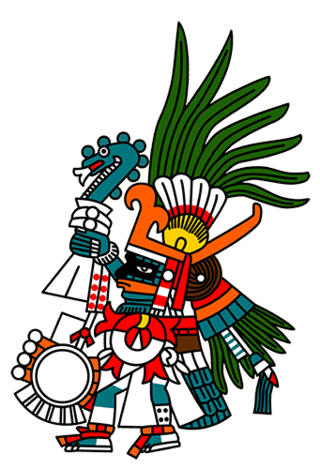
Huitzilopochtli is the solar and war deity of sacrifice in Aztec religion. He was also the patron god of the Aztecs and their capital city, Tenochtitlan. He wielded Xiuhcoatl, the fire serpent, as a weapon, thus also associating Huitzilopochtli with fire.

Tlāhuizcalpantēcuhtli is a principal member of the pantheon of gods within the Aztec religion, representing the Morning Star Venus. The name comes from the Nahuatl words tlāhuizcalpan "dawn" and tēcuhtli "lord". Tlahuizcalpantecuhtli is one of the thirteen Lords of the Day, representing the 12th day of the Aztec trecena.

In Aztec mythology, Centeōtl is the maize deity. Cintli means "dried maize still on the cob" and teōtl means "deity". According to the Florentine Codex, Centeotl is the son of the earth goddess, Tlazolteotl and solar deity Piltzintecuhtli, the planet Mercury. He was born on the day-sign 1 Xochitl. Another myth claims him as the son of the goddess Xochiquetzal. The majority of evidence gathered on Centeotl suggests that he is usually portrayed as a young man, with yellow body colouration. Some specialists believe that Centeotl used to be the maize goddess Chicomecōātl. Centeotl was considered one of the most important deities of the Aztec era. There are many common features that are shown in depictions of Centeotl. For example, there often seems to be maize in his headdress. Another striking trait is the black line passing down his eyebrow, through his cheek and finishing at the bottom of his jaw line. These face markings are similarly and frequently used in the late post-classic depictions of the 'foliated' Maya maize god.

In Aztec mythology, Tonacatecuhtli was a creator and fertility god, worshipped for populating the earth and making it fruitful. Most Colonial-era manuscripts equate him with Ōmetēcuhtli. His consort was Tonacacihuatl.

Huehueteotl is an aged Mesoamerican deity figuring in the pantheons of pre-Columbian cultures, particularly in Aztec mythology and others of the Central Mexico region. The spellings Huehuetéotl and Ueueteotl are also used. Although known mostly in the cultures of that region, images and iconography depicting Huehueteotl have been found at other archaeological sites across Mesoamerica, such as in the Gulf region, western Mexico, Protoclassic-era sites in the Guatemalan highlands such as Kaminaljuyú and Late-Postclassic sites on the northern Yucatán Peninsula. The name Huehueteotl stems from Nahuatl huēhueh ("old") and teōtl ("god"). It seems to connect the Old God to certain Mayan deities called Mam ("Grandfather").

In Aztec mythology, Xiuhtēcuhtli, was the god of fire, day and heat. In historical sources he is called by many names, which reflect his varied aspects and dwellings in the three parts of the cosmos. He was the lord of volcanoes, the personification of life after death, warmth in cold (fire), light in darkness and food during famine. He was also named Cuezaltzin ("flame") and Ixcozauhqui, and is sometimes considered to be the same as Huehueteotl, although Xiuhtecuhtli is usually shown as a young deity. His wife was Chalchiuhtlicue. Xiuhtecuhtli is sometimes considered to be a manifestation of Ometecuhtli, the Lord of Duality, and according to the Florentine Codex Xiuhtecuhtli was considered to be the father of the Gods, who dwelled in the turquoise enclosure in the center of earth. Xiuhtecuhtli-Huehueteotl was one of the oldest and most revered of the indigenous pantheon. The cult of the God of Fire, of the Year, and of Turquoise perhaps began as far back as the middle Preclassic period. Turquoise was the symbolic equivalent of fire for Aztec priests. A small fire was permanently kept alive at the sacred center of every Aztec home in honor of Xiuhtecuhtli.
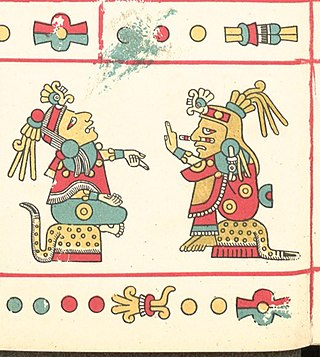
Ōmeteōtl is a name used to refer to the pair of Aztec deities Ometecuhtli and Omecihuatl, also known as Tōnacātēcuhtli and Tonacacihuatl. Ōme translates as "two" or "dual" in Nahuatl and teōtl translates as "god". The existence of such a concept and its significance is a matter of dispute among scholars of Mesoamerican religion. Ometeotl was one as the first divinity, and Ometecuhtli and Omecihuatl when the being became two to be able to reproduce all creation.
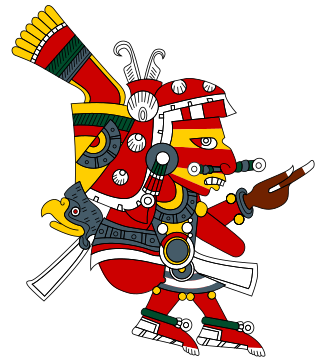
In Aztec mythology, Xipe Totec or Xipetotec was a life-death-rebirth deity, god of agriculture, vegetation, the east, spring, goldsmiths, silversmiths, liberation, deadly warfare, the seasons, and the earth. The female equivalent of Xipe Totec was the goddess Xilonen-Chicomecoatl.
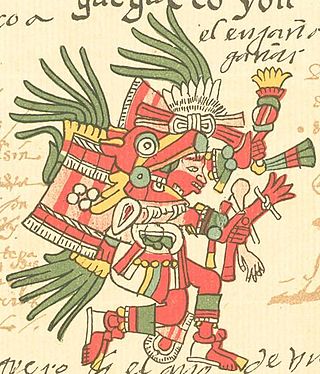
In Aztec mythology, Huēhuehcoyōtl is the auspicious Pre-Columbian god of music, dance, mischief, and song. He is the patron of uninhibited sexuality and rules over the day sign in the Aztec calendar named cuetzpallin (lizard) and the fourth trecena Xochitl.

The Aztec Empire or the Triple Alliance was an alliance of three Nahua city-states: Mexico-Tenochtitlan, Tetzcoco, and Tlacopan. These three city-states ruled that area in and around the Valley of Mexico from 1428 until the combined forces of the Spanish conquistadores and their native allies who ruled under Hernán Cortés defeated them in 1521.
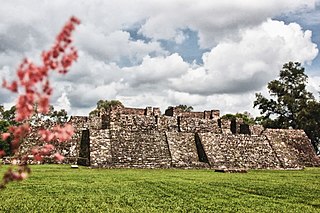
The Aztec religion is a polytheistic and monistic pantheism in which the Nahua concept of teotl was construed as the supreme god Ometeotl, as well as a diverse pantheon of lesser gods and manifestations of nature. The popular religion tended to embrace the mythological and polytheistic aspects, and the Aztec Empire's state religion sponsored both the monism of the upper classes and the popular heterodoxies.
Teōtl is a Nahuatl term for sacredness or divinity that is sometimes translated as "god". For the Aztecs teotl was the metaphysical omnipresence upon which their religious philosophy was based.

In Mesoamerican culture, Tonatiuh is an Aztec sun deity of the daytime sky who rules the cardinal direction of east. According to Aztec Mythology, Tonatiuh was known as "The Fifth Sun" and was given a calendar name of naui olin, which means "4 Movement". Represented as a fierce and warlike god, he is first seen in Early Postclassic art of the Pre-Columbian civilization known as the Toltec. Tonatiuh's symbolic association with the eagle alludes to the Aztec belief of his journey as the present sun, travelling across the sky each day, where he descended in the west and ascended in the east. It was thought that his journey was sustained by the daily sacrifice of humans. His Nahuatl name can also be translated to "He Who Goes Forth Shining" or "He Who Makes The Day." Tonatiuh was thought to be the central deity on the Aztec calendar stone but is no longer identified as such. In Toltec culture, Tonatiuh is often associated with Quetzalcoatl in his manifestation as the morning star aspect of the planet Venus.
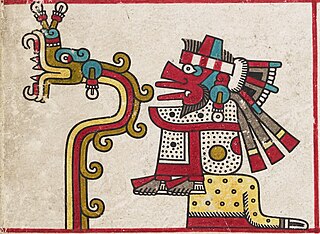
Quetzalcoatl is a deity in Aztec culture and literature. Among the Aztecs, he was related to wind, Venus, Sun, merchants, arts, crafts, knowledge, and learning. He was also the patron god of the Aztec priesthood. He was one of several important gods in the Aztec pantheon, along with the gods Tlaloc, Tezcatlipoca and Huitzilopochtli. The two other gods represented by the planet Venus are Tlaloc and Xolotl.

















